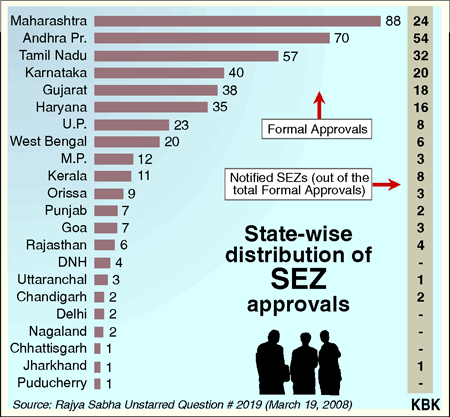Globalization and massive Industrial growth gave rise to
today’s Special Economic Zones or SEZs (as they are commonly known). They were developed with a clear goal of
providing tax incentives to huge Multi National Companies and to promote the
inclusive and exclusive growth of the host country. The first SEZs were
naturally set up in several East Asian countries which were looking towards
rapid industrialization and growth.
The first one was set up at an Airport in Ireland, but the
idea didn’t really pick speed until the 1980s, when the Chinese Dragon started
scaling the economic ladder to high growth and industrialization. Through the
1990s and the early 2000s, the world saw a huge spurt in the number of SEZs. Even
India got on the bandwagon and came up with the SEZ policy in 2000 looking to
unleash a new
chapter of industrial and manufacturing growth.
With that aim clear in mind, SEZs should have probably
revolutionized the investment climate in any country willing to offer such
incentives and infrastructure. Today, there are over 4000 SEZs across the
globe, with a majority of them lying in developing countries (for obvious
reasons).And new ones keep coming up or are in the planning process. But,
despite these huge numbers, a majority of them haven’t been able to account for
the kind of growth that they should have.
In India too, their performance has been dismal. There are
around 580 SEZs approved by the government; but only around 200 are
operational. That is a disheartening figure for a country which has recently
launched campaigns like Make in India and is aiming at double digit growth
rates within a decade. One may think
that 200 operational SEZs is a good number for India; however, out of those
operational, the ones which are profitable are very few.
The real sheen behind an SEZ is the list of tax incentives
and exemptions that the government is willing to offer, in return for the
company’s investment and operations. However, as ambitious as Make in India
sounds, it fails to perform on paper. As per the SEZ policy, companies were
exempt from paying the Minimum Alternate Tax MAT) levied on book profits and
the Dividend Distribution Tax (DDT). However, these tax lollies have been
snatched away from the companies. In late 2014, the government announced an
18.5% MAT on book profits; a move which has been highly criticized by the
commerce ministry.
It seems that the government wants to achieve its growth
targets but, without letting go of its cash kitty. What the government needs to
understand is that, if it does take away some of these tax benefits; it has to
be ready with some other incentive which can compensate for it. However, there
is complete deadlock in the further development of SEZs.
Like all Industrial zones, SEZs are also located outside the
limits of cities and metropolitans. This arrangement requires setting up of
minimum infrastructure in order to enable functionality. The infrastructure
includes high quality roads fit for heavy machinery and equipment, a robust
rail network, along with ports and airports.
But, all that is secondary to tax exemptions. Relief from
unnecessary taxes is the primary driver that makes an SEZ attractive to
multinational corporations. If that isn’t offered, the company may set up its
business on a different piece of land, with better infrastructure and
connectivity. The commerce industry was hoping that the budget would include
such reliefs, but that didn’t happen.
The Prime Minister has made lavish boasts of how the government is
cutting the red tape and improving the ease of doing business; however right
now, these are nothing but big words with little backing. A recent report
stated that developers have pulled back from 61 approved SEZ projects in
Maharashtra.
From the look of it, it may seem that the government has
given up on the SEZ dream; but it isn’t so. The story of Sanand district in
Gujrat is a major driver towards this cause. Sanand is rapidly on its way to
becoming the automobile hub of India; and has also been flamboyantly referred
to as the next Detroit in making. The portfolio of high profile manufacturers
includes TATA Motors, Ford, Hitachi, Citroen and Cadila Healthcare.
This is truly a welcoming step, but such moves should not be
limited to certain districts of the country. The incentives being offered there
should be generalized to other industrial hubs of the country as well. Instead
of spending money on opening of new SEZs, the funds should be diverted towards
infrastructure development.
It isn’t too late for India to unleash its growth potential.
But, retrospective taxation will take the investment climate to its doom. For
SEZs and the industries to flourish, the government has to let go of its
control and provide multinationals with opportunity on a silver plate. Basic
Infrastructure facilities like Electricity, connectivity with railways, ports
and airports should be developed to end negative sentiment towards SEZs in
India.









No comments:
Post a Comment